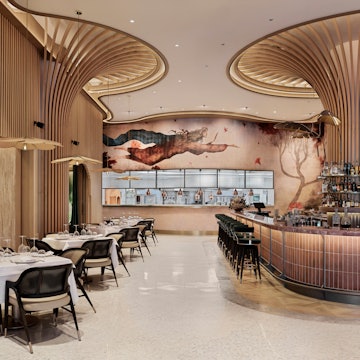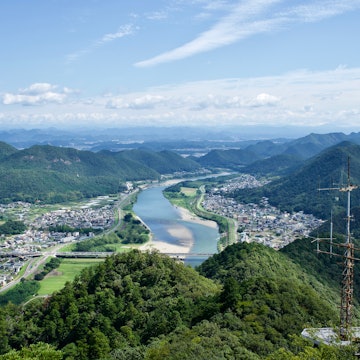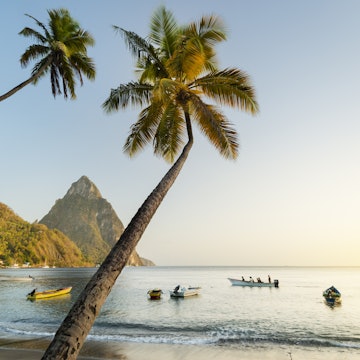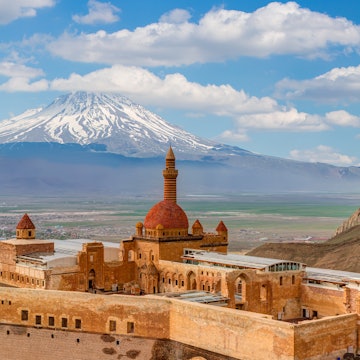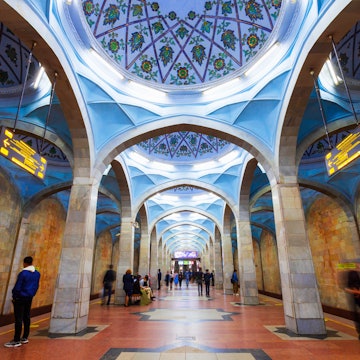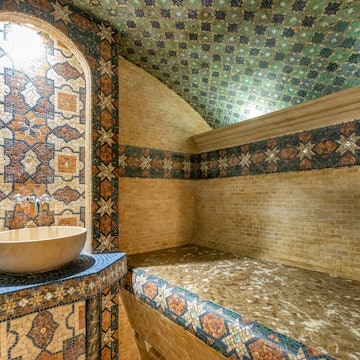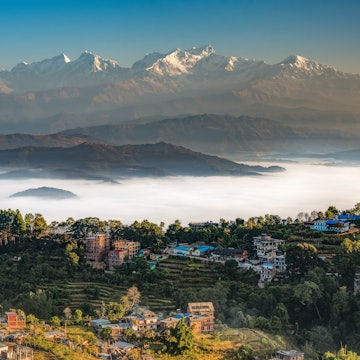

Tajikistan's Pamir-Alai mountain range. Photo Volcano/Shutterstock
The smallest of the five Central Asian countries, Tajikistan is a mountainous nation tucked between China to the east, Uzbekistan to the west, Kyrgyzstan to the north, and Afghanistan to the south.
With snow-peaked ranges punctuating the skies, slabs of enormous rock formations spanning shades of brick red to charcoal grey, and glacial run-off pouring into churning white rapids, Tajikistan is ideal for hiking, camping and taking advantage of the innumerous viewpoints overlooking the lakes and rivers.
If you’re interested in history in addition to natural beauty, look no further. This nation of 10 million people has witnessed the hustle and bustle of the Silk Road, the might of the Soviet Union at its peak, and visits from the likes of Alexander the Great and Chinggis Khan. We've culled together everything you need to know about planning your first trip and what to expect when you arrive.
When should I go to Tajikistan?
With 93% of Tajikistan covered in mountains, there’s a big difference in temperature between the lower and higher elevations. Most of the country's cities are located in the lowlands and the summers are dry with temperatures ranging between 23°C to 30°C (73°F to 86°F). In the winter months, it’s typically closer to −1°C to 3°C (30.2°F to 37.4°F). In the mountainous regions, temps can reach -20°C (-4°F) and up to 150 cm (59in) of snowfall.
Considering the plethora of outdoor activities, ranging from hiking and camping around the countless trails and mountains to horseback riding and fishing, the most popular months to visit are May, June, September and October. For those who love winter landscapes and hiking in the snow, be mindful that avalanches and floods are common from December through March. The largest official holiday in the country is Navruz, the Persian New Year. To catch the colorful outfits, elaborate table settings and floral launch of springtime, plan your trip around the big day on March 21.
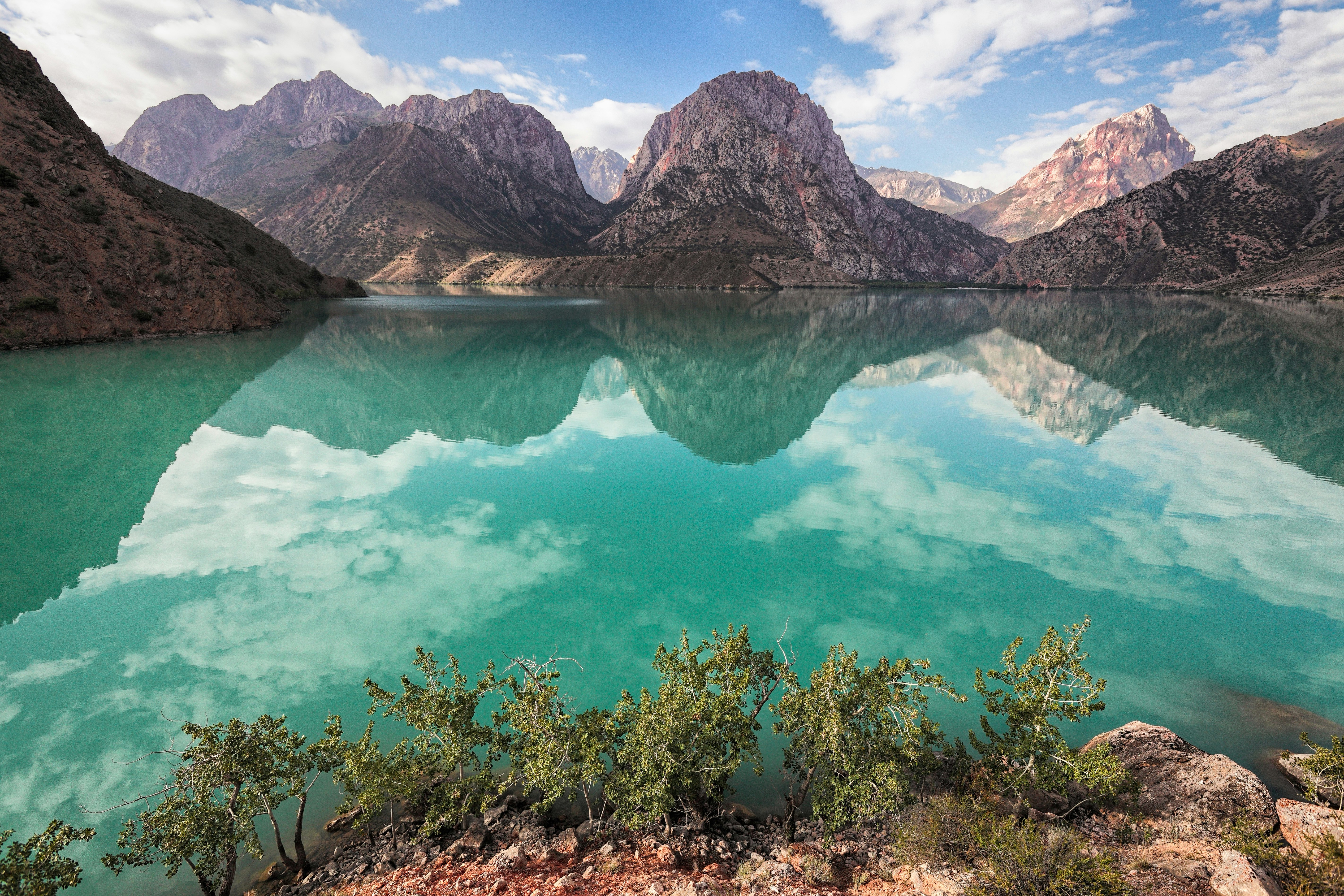
How much time do I need in Tajikistan?
To see the highlights of Dushanbe, two full days are sufficient. Hisor and Safed Dara are easy day trips while Iskander-Kul is an overnight trip. Take two or three days for trips to Khujand or Panjakent. For a visit to the Pamirs, most people take between seven to twelve days.
Is it easy to get to and around Tajikistan?
The largest airport, DYU, in the capital Dushanbe services flights from 11 countries. It’s the primary international hub for entering and exiting from other countries, and the two largest connecting cities are Dubai, via Fly Dubai, and Istanbul, via Turkish Airlines.
Citizens of several former Soviet nations can enter Tajikistan without a visa and stay indefinitely. For most other countries, the maximum stay is 30 days. You can travel visa-free if your country is on the exempt list; otherwise, you can apply for a tourist visa online. Check out the official e-visa portal for the most up-to-date information.
If you’re staying more than 10 days, there is an obligatory registration process with OVIR (the Ministry of Internal Affairs). Don’t forget to do it within the first 72 hours you are in-country.
Within cities, there are marked official taxis as well as informal taxis that follow the same routes as buses and cost just a little more. Major cities will also have buses and marshrutkas (minivans that operate as buses) which are labeled clearly. Larger cities have taxi apps, such as Maxim, Rakhsh, and Yak, and in Dushanbe, official street taxis use meters. To travel between cities, there are shared taxis that leave when they’re full, or you can pay for four seats and take it as a private taxi – it’s cheaper than paying for an actual private taxi!
Top things to do in Tajikistan
Soak up spectacular views
In the capital city of Dushanbe, there are two great spots to catch a view overlooking the whole city. The most popular is from the top of Istiklol Monument, a new tower with an art and culture museum on the first two floors and an observation deck on the 14th floor with a 360-degree view of the city.
Another fantastic viewpoint is from Victory Park, just on the outskirts of the city center. There is a memorial dedicated to fallen soldiers during World War II at the top of a long flight of stairs and an impressive IS-2 tank with two monumental towers down to one side. Wooden gazebos are dotted throughout the park, and on the weekends, you can go horseback riding along the many trails.

Take in the architecture
The country’s architecture is a distinct mix of its historical influences. The Silk Road influence is notable in the Mehrgan traditional bazaar, with its Central Asian white columns and natural skylight illuminating the produce vendors below. Stop by the Rohat Teahouse to admire the paintings on the high ceilings and walls reminiscent of traditional tea houses from centuries past, and have some local cuisine while you’re there. The beautiful Opera Ballet Theater is one of the few remaining central buildings constructed during the Soviet era and is another must-see venue.
Try some winter sports
If you’re visiting Dushanbe in the winter, head to the only ski resort in the country, Safed Dara, just one hour from the capital. Ski and snowboard rentals are available, and three gondola routes access different slopes depending on your preferred difficulty level. There’s also ice skating, tubing, jet skiing, and horseback riding on the ground level. Multiple restaurants are on-site as well as a hotel for overnight stays.
Get to know the Pamirs
One of the main reasons people visit Tajikistan is the Pamir Mountains in the east. The landscape is breathtaking, but the region is also home to the Pamir people whose unique traditions, customs, food and language are well-known throughout the country.

My favorite thing to do in Tajikistan
One of my favorite trips is to head out to Hisor, about 30km (18.6 miles) away from Dushanbe. In the spring, catch a buzkashi game, a sport played on horseback where players hoist a goat carcass across a line. The historical ruins of the Hisor Fortress are an easy visit, with an ancient arched doorway dating back 2500 years and a newly renovated wall. Walking distance from the fort is the famous Qarayev restaurant, where you can sit at a traditional Tajik outdoor table next to the river and enjoy spiced chicken and fresh fish. Don’t miss a chance to see one of the most unique buildings in the world on the way to and from Hisor – a watermelon-shaped tea house.
How much money do I need in Tajikistan?
Tajikistan is a budget-friendly country. The biggest expenses are car rentals and top-tier hotel stays. These are the average daily costs you can expect:
Private taxi ride: US$2 (TJS$19)
Local bus ride: US$0.25 (TJS$2.37)
One room in a 5-star hotel for 2 adults: US$45 (TJS$427)
One dormitory bed in a budget hostel: US$8 (TJS$76)
One order of plov: US$3 (TJS$28.50)
Nine-day transportation, driver and gas to the Pamirs for 4 people: US$2000 (TJS$18,999)
One night at a homestay, including breakfast and dinner, in GBAO: US$25 (TJS$237)

Things to keep in mind
Be mindful of how you dress
While Tajikistan is officially a secular government due to a long Soviet influence, Islam is the predominant religion and still plays a large role in the everyday life of the locals. Women dress more conservatively, almost always covering shoulders, knees, and for many, also their heads.
Brace for the air quality
If you are sensitive to particle pollution or have respiratory issues, take note that Dushanbe is in a valley surrounded by mountains and automobile emissions and coal-powered plants can lead to poor air quality. Use medical masks or stay indoors when the AQI (Air Quality Index) is over 100.






